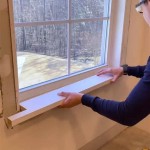Cutting In: Essential Tips for Professional-Looking Interior Painting
Cutting in is a crucial technique in interior painting that involves applying paint to the edges and corners where walls meet ceilings, moldings, and other architectural features. This precision step ensures a clean and polished finish, preventing sloppy paint overlaps and uneven lines.
Mastering cutting in requires attention to detail and a steady hand. Here are some essential tips to help you achieve professional-looking results:
1. Use the Right Brush
A high-quality brush designed for cutting in is essential. Choose a brush with a tapered or angled tip and soft, synthetic bristles. The angled tip allows for precise paint placement, while the soft bristles prevent streaks and minimize brush marks.
2. Load the Brush Lightly
Avoid overloading the brush with paint. Dip the brush into the paint about halfway and gently tap off any excess. A slightly underloaded brush provides better control and reduces the risk of drips and splatters.
3. Start from the Outside In
Begin cutting in from the outside edges and work your way towards the center. This allows you to establish a defined border and gradually blend the paint into the wall. Use smooth, even strokes to create a clean line.
4. Use a Painter's Tape
Painter's tape is a valuable tool for creating sharp lines and protecting adjacent surfaces from accidental paint spills. Apply the tape along the edges of the area you're cutting in, ensuring it adheres well and creates a secure barrier.
5. Overlap Strokes Slightly
When cutting in multiple areas, overlap your brush strokes slightly to avoid visible gaps. Aim for a 50% overlap to ensure complete coverage and a uniform appearance.
6. Check for Runs and Drips
As you cut in, periodically check for runs or drips. Wipe them away with a clean, damp cloth immediately to prevent them from drying and becoming noticeable.
7. Remove Painter's Tape Carefully
Once the paint has dried sufficiently, carefully remove the painter's tape. Pull the tape away at a 45-degree angle to avoid peeling off any of the freshly painted surface.
Additional Tips:
* Practice on scrap paper or cardboard before cutting in on the actual walls to develop your technique. * Use a well-lit area to ensure you can see clearly while cutting in. * Take your time and don't rush the process. Precision and attention to detail are key. * If you're cutting in a large area, consider using a paint sprayer for faster and more even coverage. * Clean your brush thoroughly after each use to remove any paint residue and extend its lifespan.
How To Cut In When Painting Without Tape Canary Street Crafts

Pro Tips To Cut In Ceiling Paint Easily

Cut In Like A Pro

How To Cut In When Painting Without Tape Canary Street Crafts

Perfect Ceiling Cut Ins Painting A Straight Line On Wall How To In Paint Edges

Mastering Ceiling Cutting In Cut Tips From The Idaho Painter

Cutting In Top Tips To Get The Perfect Edge Inspirations Paint

Diy Interior Wall Painting Tips Techniques With Pictures Family Handyman

Cutting In Tips For Painting

Diy How To Tips For Cutting In A Wall When Painting Pro Painter Secrets Revealed
Related Posts








